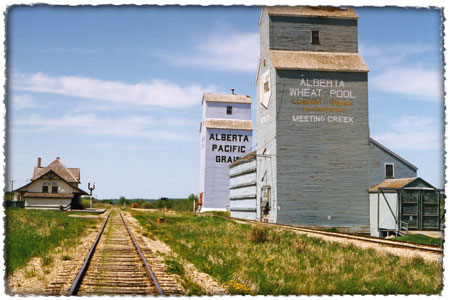The first work is one of author Martha Ostenso’s, her novel Wild Geese,
 which is noted for a particularly realist approach to storytelling. The characters in the book all face real and common problems of what the citizens of the west had faced throughout much of their history. Based in a small Saskatchewan town called Oeland, the children of the Gare family have a hard time escaping the traditional tyranny of a farming father dedicated to the land. In Susan Wood’s article “God’s Doormats: Women in Canadian Prairie Fiction,” from the Journal of Popular Culture, the realist aspects of Canadian literature are attended to. More specifically, the role of the female figure, her hardships, and the obstacles she faced in adjusting to the Prairies are Wood’s focus in addressing the growth of a Canadian Nation. She mentions that the real focus of Wild Geese “is on the rebellion of Amelia Gare, a true ‘doormat’ kept in fearful submission to her brutal husband Caleb; and of her daughter Judith.” Her constant reference throughout her article to women as ‘doormats’ intends to bring light to the importance women played alongside their dominant male companions. She praises Wild Geese for its “rejection of romantic formulas and stereotypes, a concern with actual conditions and their psychological effects.” Herein lays one necessary aspect towards formulating the effect of Prairie regionalism within Canadian Nationalism. The struggle in a Prairie woman’s life, also gave meaning to her life. This attributes to the ‘strength’ thought of within Canadian nationalism that other regional authors commonly relate to in their works as well.
which is noted for a particularly realist approach to storytelling. The characters in the book all face real and common problems of what the citizens of the west had faced throughout much of their history. Based in a small Saskatchewan town called Oeland, the children of the Gare family have a hard time escaping the traditional tyranny of a farming father dedicated to the land. In Susan Wood’s article “God’s Doormats: Women in Canadian Prairie Fiction,” from the Journal of Popular Culture, the realist aspects of Canadian literature are attended to. More specifically, the role of the female figure, her hardships, and the obstacles she faced in adjusting to the Prairies are Wood’s focus in addressing the growth of a Canadian Nation. She mentions that the real focus of Wild Geese “is on the rebellion of Amelia Gare, a true ‘doormat’ kept in fearful submission to her brutal husband Caleb; and of her daughter Judith.” Her constant reference throughout her article to women as ‘doormats’ intends to bring light to the importance women played alongside their dominant male companions. She praises Wild Geese for its “rejection of romantic formulas and stereotypes, a concern with actual conditions and their psychological effects.” Herein lays one necessary aspect towards formulating the effect of Prairie regionalism within Canadian Nationalism. The struggle in a Prairie woman’s life, also gave meaning to her life. This attributes to the ‘strength’ thought of within Canadian nationalism that other regional authors commonly relate to in their works as well. In a much less recognized book by Florence Gates, called Back to the Coteau Hills, the theme of a ‘true north strong and free’ is further enforced. The book is Florence’s personal narrative of
 her family’s journey to establish a settlement in southern Saskatchewan. In her introduction she quotes President F.D. Roosevelt when he said that “The West attracts the kind of people who like to do things first.” Furthermore, she mentions that her grandfather, Louis Napoleon Giauque, “descended from French Acadians who fled persecution in Acadia, now the maritime provinces in Canada, to relocate” eventually to the area in southern Saskatchewan known as the Coteau Hills (along lake Diefenbaker). The subject of culture and nationalism is constantly brought to attention by referencing the heritage of those around her. Because this book portrays such a universal historical re-enactment of Prairie identity, for many readers it will also reinforce much of the stereotypical visions of Prairie identity that today, may becoming less and less a reality into the future. On this note the last article to mention then is a pessimistic viewpoint of Prairie regionalism and nationalisms existence.
her family’s journey to establish a settlement in southern Saskatchewan. In her introduction she quotes President F.D. Roosevelt when he said that “The West attracts the kind of people who like to do things first.” Furthermore, she mentions that her grandfather, Louis Napoleon Giauque, “descended from French Acadians who fled persecution in Acadia, now the maritime provinces in Canada, to relocate” eventually to the area in southern Saskatchewan known as the Coteau Hills (along lake Diefenbaker). The subject of culture and nationalism is constantly brought to attention by referencing the heritage of those around her. Because this book portrays such a universal historical re-enactment of Prairie identity, for many readers it will also reinforce much of the stereotypical visions of Prairie identity that today, may becoming less and less a reality into the future. On this note the last article to mention then is a pessimistic viewpoint of Prairie regionalism and nationalisms existence.Gerald Friesen, in his article “Defining the Prairies or, Why the Prairies Don’t Exist,” a chapter from Robert Wardhaugh’s Toward Defining the Prairies: Region, Culture, and History, plays the role of the critic in pitching the notion that the Prairie identity has disappeared. In response to the impact of realist novels like Ostenso’s and Gates’, Friesen finds that the Prairies that exist
 today have little in common with their typical Prairie past. His proposal is that the period from 1867 to the 1930’s “were sufficient to define a new prairie region.” Due to the regions progress, its identity today is far different from the one given to it by the authors writing of its characteristics during his outlined period. He feels that the now “eight percent of prairie Canadians actually engaged in farm production” constitutes a necessity to perhaps re-define a new region.
today have little in common with their typical Prairie past. His proposal is that the period from 1867 to the 1930’s “were sufficient to define a new prairie region.” Due to the regions progress, its identity today is far different from the one given to it by the authors writing of its characteristics during his outlined period. He feels that the now “eight percent of prairie Canadians actually engaged in farm production” constitutes a necessity to perhaps re-define a new region.Three Day Road
Three Day Road by Joseph Borden is characteristic literature when it comes to Canadian Nationalism within terms of Native peoples. It is the first novel that he has written, being of Native descent himself, but was nicely done. Explained through flashbacks the book talks about how natives were treated within society not just with the main characters but also with the antagonist reminiscing about her childhood. It takes the reader on a timeline of native treatment within Canadian society. Their culture was suppressed and the book sets out to portray this. It also touches on assimilation and how the natives fall prey to the white man and their ways. This can be tied in with articles we have touched on in class. In the Sharon Wall article, Totem Poles, Teepees, and Traditions: ‘Playing Indian’ in Ontario Summer Camps, 1920-1955, she touches on how the children are taught original native ‘traditions’ and how many Natives don’t necessarily embrace those traditions anymore but have been assimilated into British or Canadian society. This seems to raise even more problems when considering Canadian culture, because there is a large population of natives living in Canada and they did/do have their own sense of nationalism unique to ours. Natives also have their own literature, many books are written about their own history and stories that they have to tell. With a long tradition of story telling most of their history is passed on through oral tradition. So not only is prairie literature different and important but the high population of Natives living there and all throughout Canada needs equal consideration.
Somewhere between Wood, Wall and Friesen’s attempts at engaging a Prairie and Canadian Nationalism is suitably the best place to answer our two questions. The region of the Prairies has had clear impact on the focus and atmosphere of its author’s attention and in turn an effect back on its people in understanding their shared struggles and history. Here is also where the contribution to Canadian Nationalism can be found. The portrayal of the Prairies as a vast farmland worked over by the hardened farmer combines with the struggles of other fellow Canadians who share a different struggle of equal importance. Part of defining a culture includes having shared historical experience, and the traditional distinctiveness of the Prairies plays into the Canadian as the ‘true north, strong and free’.






















No comments:
Post a Comment